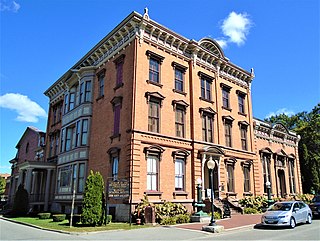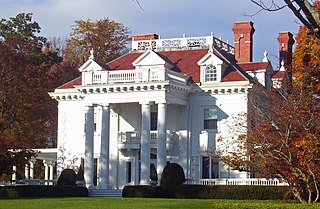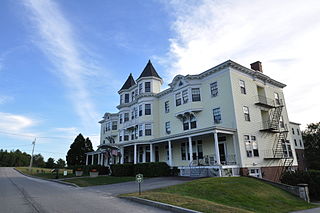
Poland Spring is a brand of bottled water, produced in Poland, Maine. It is named after the original natural spring in the town of Poland, Maine it was drawn from. Today it is a subsidiary of BlueTriton Brands, formerly Nestlé Waters North America, and sold in the United States. The spring was first exploited commercially in 1859 by Hiram W. Ricker, owner of a nearby inn. Contemporary demand is so great the brand's water is derived from multiple sources in the state of Maine including Poland Spring and Garden Spring in Poland, Maine, Clear Spring in Hollis, Evergreen Spring in Fryeburg, Spruce Spring in Pierce Pond Township, White Cedar Spring in Dallas Plantation, and Bradbury Spring in Kingfield, and Cold Springs in Denmark.

The Maine State Building is a historic building on Preservation Way, part of the Poland Springs resort complex in South Poland, Maine. It was built in 1893 at the Columbian Exposition in Chicago. Designed by Chicago architect Charles Sumner Frost, a Lewiston, Maine native and MIT graduate, the building was constructed of granite with a slate roof. All the materials were from Maine and crafted by craftsmen and companies from Maine. At the fair, the building was filled with displays about the State of Maine.

Canfield Casino and Congress Park is a 17-acre (6.9 ha) site in Saratoga Springs, New York, United States. It was formerly the site of the Congress Hotel, a large resort hotel, and the Congress Spring Bottling Plant, as well as Canfield Casino, which together brought Saratoga Springs international fame as a health spa and gambling site. At the peak of its popularity it was a place where the wealthy, major gamblers and stars of the entertainment world mingled. The park's artwork includes a statue by Daniel Chester French and landscape design by Frederick Law Olmsted, among others.

Bathhouse Row is a collection of bathhouses, associated buildings, and gardens located at Hot Springs National Park in the city of Hot Springs, Arkansas. The bathhouses were included in 1832 when the Federal Government took over four parcels of land to preserve 47 natural hot springs, their mineral waters which lack the sulphur odor of most hot springs, and their area of origin on the lower slopes of Hot Springs Mountain.

All Souls Chapel is a historic chapel at the Poland Spring Resort in Poland, Maine. It was built in 1912. In 1977, it was added to the National Register of Historic Places.

Keystone Mineral Springs is an historic mineral water bottling facility on Keystone Spring Road in Poland, Maine. Located along the former right-of-way of Keystone Spring Road in eastern Poland, the facility consists of two structures, a spring house built c. 1885 and a bottling house built in 1929. The facilities are, along with the more well-known Poland Spring Bottling Plant and Spring House, the only known surviving elements of the early period of mineral water bottling in Maine. The property was listed on the National Register of Historic Places in 2005.

The Poland Spring Beach House is an historic building on Maine State Route 26 in South Poland, Maine. It was built in 1909 as part of the extensive Poland Spring Resort, and was originally floated on Middle Pond on pontoons. It was set permanently on land in the 1930s, and converted into a private residence in the 1980s. It was listed on the National Register of Historic Places in 1999.

The Henry I. Harriman House is a historic French château style house at 825 Centre Street in Newton, Massachusetts. Built in 1916 for Henry I. Harriman, it is one of Newton's most elegant 20th-century suburban estate houses. It is now part of the campus of the Boston College Law School. It was known as Putnam House, in honor of benefactor Roger Lowell Putnam, when the campus was that of Newton College of the Sacred Heart. It was listed on the National Register of Historic Places in 1990.

The United States Post Office and Courthouse is a courthouse of the United States District Court for the Eastern District of North Carolina, located in New Bern, North Carolina. The building was completed in 1935, and was listed in the National Register of Historic Places in 1973, as a contributing building within the New Bern Historic District, and was individually listed in 2018.

South Parish is the historic name of a church at 292 State Street in Portsmouth, New Hampshire, in the United States. The church building, built in 1824-26, is one of the earliest examples of Classical Revival architecture in New England, and was listed on the National Register of Historic Places in 1979.

Hiddenhurst is the former estate of businessman Thomas Hidden, on Sheffield Hill Road in the Town of North East, New York, United States, south of the village of Millerton. It is an elaborate frame house built at the beginning of the 20th century in the neo-Georgian architectural style.
The Union School is a historic former school building on Mt. Ephraim Road in Searsport, Maine. Built in 1866, it is one of the town's prominent former public buildings, and an important surviving school commission of architect George M. Harding. It was listed on the National Register of Historic Places in 1993. It has been converted into apartments.

The Hanover Town Library, more commonly known as the Etna Library, is a historic library located at 130 Etna Road in Hanover, New Hampshire, United States. It primarily serves the Etna section of the town; the Classical Revival building it occupies was the first purpose-built library building in the town, and is listed on the National Register of Historic Places. It is a modest brick building, designed by Dartmouth College professor Robert E. Fletcher and built in 1905.

The Public Library of Paris, Maine, is located at 37 Market Square in the town of South Paris, Maine. The original portion of its building, a Colonial Revival brick structure built in 1926, was one of the last designs of the Portland architect John Calvin Stevens, and was listed on the National Register of Historic Places in 1989.
The Turrets is a historic summer estate house on Eden Street in Bar Harbor, Maine. Designed by New York City architect Bruce Price and built in 1895, the French Chateau-style building was one of the most elaborate built in Bar Harbor during its heyday as a summer resort. It is now part of the campus of the College of the Atlantic, and was listed on the National Register of Historic Places in 1974.

The Pittsfield Public Library is located at 110 Library Street in Pittsfield, Maine. The building it occupies is a Beaux-Arts building designed by Albert Randolph Ross, and was built in 1903-04 with funding assistance from Andrew Carnegie. The building was listed on the National Register of Historic Places in 1983. It is one of the state's oldest Beaux-Arts buildings, and one of the most architecturally distinctive in the town.
The Philler Cottage, previously the Dark Harbor House Inn, is a historic house at Pendleton Point and Jetty Roads in Islesboro, Maine. Built in 1894 for a wealthy Philadelphia banker, it is a high-quality regional example of a Georgian Revival summer house. It was listed on the National Register of Historic Places in 1985.

The Poland Springs Historic District encompasses the area that was once Maine's premier inland summer resort, renowned for the supposed curative powers of its spring waters. Located on the north side of Maine Street in South Poland, Maine, United States, it includes surviving resort buildings in a landscaped environment that includes a golf course, as well as the earliest bottling facilities of water distributor Poland Spring. The district was listed on the National Register of Historic Places in 1984. Most of the district is now occupied by the Poland Springs Resort complex.

The Scampini Block is a historic commercial building at 289 North Main Street in the city of Barre, Vermont. Built in 1904, it is an elegant showcase of the skills of local granite carvers, and was for many years a social center for the area's large immigrant stoneworkers. It was listed on the National Register of Historic Places in 2007.

The Twin City Historic District in Twin City in Emanuel County, Georgia is a historic district which was listed on the National Register of Historic Places in 2014.




















